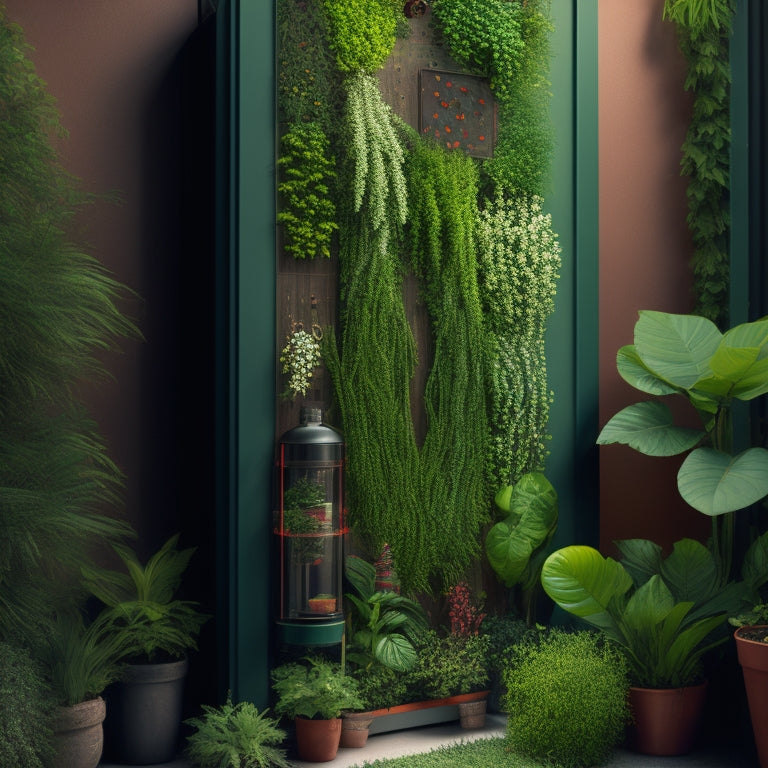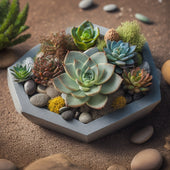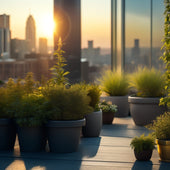
Pest Control Strategies for Vertical Gardens
Share
When managing your vertical garden, it's crucial to have a multifaceted pest control strategy in place. You'll need to identify common pests like aphids, whiteflies, and spider mites by monitoring for signs of stress, damage, or unusual behavior. Combine organic methods like companion planting and essential oils with biological controls that promote beneficial insect habitats. Physical barriers and chemical controls can also be used, but as a last resort. By understanding these strategies and implementing them effectively, you'll be well on your way to protecting your plants from damage. Next, you'll want to explore the specifics of each method to guarantee your garden remains pest-free and thriving.
Key Takeaways
• Identify common pests in vertical gardens, such as aphids, whiteflies, and spider mites, to develop targeted control strategies.
• Implement organic methods like companion planting, essential oils, and biological controls, such as natural predators and beneficial insect habitats.
• Use physical barriers like fine-mesh screens and row covers to prevent pest establishment and combine with other control methods for robust defense.
• Apply chemical control as a last resort, choosing low-toxicity options and following safety precautions, application best practices, and PPE guidelines.
• Consider environmental impacts, promote sustainable practices, and engage in continuous education on safe pesticide practices and emerging technologies.
Common Pests in Vertical Gardens
As you cultivate your vertical garden, you're likely to encounter a range of pests that can compromise its health and productivity, including aphids, whiteflies, spider mites, and mealybugs.
To effectively manage these pests, it's vital to develop expertise in pest identification techniques. Mastering these techniques will enable you to accurately diagnose infestations, allowing you to respond promptly and effectively.
When it comes to preventive maintenance strategies, a thorough understanding of your garden's ecosystem is fundamental. Regularly inspect your plants, paying attention to signs of stress or damage that may indicate pest activity.
Implementing good gardening practices, such as maintaining ideal temperature and humidity levels, pruning, and providing adequate air circulation, can also help prevent pest infestations.
Additionally, introducing beneficial insects, like ladybugs or lacewings, can help control pest populations naturally. By combining these strategies, you'll be well-equipped to protect your vertical garden from common pests and guarantee a thriving, productive harvest.
Identifying Early Warning Signs
You must scrutinize your plants regularly to detect the initial indications of pest infestation, which can be subtle yet essential in preventing extensive damage.
During garden monitoring, look for unusual pest behavior, such as aphids clustering on stems or whiteflies hovering around leaves. Inspect your plants from top to bottom, paying attention to any discoloration, distortion, or holes on leaves and stems. Check for eggs, larvae, or actual pests on the undersides of leaves, in leaf axils, or on stems.
Early warning signs can be physical, such as actual pest sightings, or visual, like yellowing or stunted growth. Be aware of any changes in plant appearance, even if they seem minor. Note any unusual odors or sounds, as some pests can cause distinctive smells or noises.
Organic Pest Control Methods
For effective management of pest infestations, incorporating organic control methods into your vertical garden care routine is essential, allowing you to maintain a balanced ecosystem while minimizing harm to the environment.
One approach you can take is companion planting, where you strategically place certain plants alongside each other to deter pests. For example, basil repels aphids and whiteflies, while marigolds ward off nematodes.
Another method is using essential oils, which can be applied directly to plants or mixed with water and sprayed as a foliar treatment. Certain essential oils, such as peppermint and lemongrass, have natural insecticidal properties that can help control pest populations. When using essential oils, be sure to dilute them properly and test them on a small area first to avoid any phytotoxicity.
Using Physical Barriers Effectively
By installing physical barriers, such as fine-mesh screens or fine-netted row covers, you can prevent pests like whiteflies, aphids, and spider mites from reaching your vertical garden plants in the first place. This proactive approach is particularly effective in vertical gardens, where plants are often more densely packed and more susceptible to pest infestations.
To get the most out of physical barriers, it's important to understand the different types and their uses. Here's a breakdown:
| Barrier Type | Pest Control Benefits |
| Fine-mesh screens | Exclude whiteflies, aphids, and spider mites |
| Fine-netted row covers | Protect plants from egg-laying and larval stages |
| Coarse-mesh screens | Allow for airflow while keeping out larger pests |
| Insect netting | Provides a physical barrier for individual plants |
When using netting techniques, verify the mesh size is small enough to prevent pests from passing through. Row covers should be applied at planting time to prevent pests from establishing themselves. By combining these physical barriers with other control methods, you can create a robust defense against pests in your vertical garden.
Implementing Biological Controls
As you implement biological controls in your vertical garden, you'll want to focus on three key strategies to guarantee effective pest management.
You'll need to select natural predators that target specific pests, create habitats that attract beneficial insects, and strategically deploy parasitic wasps to combat infestations.
Natural Predator Selection
You can harness the power of natural predators to control pests in your vertical garden by introducing beneficial insects that prey on problem species.
Ladybugs, for instance, are a popular choice for aphid management. These tiny beetles are voracious predators that can consume hundreds of aphids per hour. Their benefits extend beyond aphid control, as they also feed on other soft-bodied insects, such as mealybugs and spider mites.
When selecting natural predators, it's crucial to choose species that are specific to your target pest. This guarantees that the beneficial insects will target the problem species without harming non-target organisms. For example, lacewings are effective predators of whiteflies, while parasitic wasps target caterpillars.
Introduce natural predators when pest populations are low to maximize their impact. Monitor your garden regularly to confirm that the beneficial insects are establishing themselves and controlling pest populations.
Beneficial Insect Habitats
Creating beneficial insect habitats is essential for implementing biological controls, as these microenvironments provide the necessary resources for natural predators to thrive and effectively manage pest populations in your vertical garden.
By intentionally designing and incorporating habitat creation into your garden, you'll attract beneficial insects that prey on pests, reducing the need for chemical pesticides.
To create ideal habitats, you'll need to take into account factors such as shelter, food, water, and breeding sites. Incorporate native plants that provide nectar, pollen, or shelter for beneficial insects. For example, plant species like marigolds, dill, or fennel attract ladybugs and lacewings, which prey on aphids and whiteflies.
You can also create beetle banks or insect hotels using materials like bamboo, straws, or wood to provide shelter and breeding sites.
Parasitic Wasp Deployment
Deploying parasitic wasps, such as Trichogramma or Cotesia, can be an effective biological control method in your vertical garden, as these tiny insects prey on pest eggs and larvae, disrupting their life cycles. By introducing these wasps, you're leveraging their natural behavior to target specific pests, reducing the need for chemical pesticides.
To maximize the effectiveness of parasitic wasp deployment, it is crucial to understand their behavior and preferences. Consider the following factors when implementing this strategy:
| Factor | Consideration |
|---|---|
| Wasp species | Choose species specific to your target pest |
| Release timing | Coordinate releases with pest life cycles |
| Wasp density | Guarantee adequate wasp numbers for effective control |
| Environmental factors | Provide ideal temperature, humidity, and food sources |
| Monitoring | Regularly track wasp activity and pest populations |
Chemical Control as Last Resort
How often do chemical pesticides become the only viable solution when all other pest control methods have failed in your vertical garden? Although chemical control should be a last resort, there are situations where it's unavoidable.
Before resorting to chemical pesticides, it's vital to explore alternative solutions and take necessary safety precautions.
Here are three key considerations when using chemical control:
-
Always choose chemical alternatives with low toxicity to minimize harm to beneficial insects and the environment.
-
Wear personal protective equipment (PPE), including gloves, masks, and eye protection, to prevent exposure to toxic substances.
-
Follow label instructions carefully to avoid overapplication, which can lead to pesticide resistance and environmental contamination.
When using chemical pesticides, it's important to carefully evaluate the risks and benefits.
Consider the potential impact on non-target species, soil health, and water quality. By exercising caution and following best practices, you can minimize the risks associated with chemical control and maintain a healthy, thriving vertical garden.
Frequently Asked Questions
How Often Should I Inspect My Vertical Garden for Pests?
You should inspect your vertical garden for pests at least weekly, ideally during early morning or evening when pests are most active, to guarantee timely pest identification and prompt intervention, adjusting inspection frequency as needed based on plant growth and environmental factors.
Can I Use Neem Oil on Edible Plants in My Vertical Garden?
Carefully crafting your control methods, you can confidently use neem oil on edible plants, leveraging its natural nematode-destroying benefits as a gentle, organic pest control solution that safeguards your succulent harvests.
Will Beneficial Insects Harm My Vertical Garden's Plants?
You won't need to worry about beneficial insects harming your plants; in fact, they'll enhance plant health by pollinating and controlling pests, allowing you to maintain a balanced, thriving ecosystem in your vertical garden.
Do UV Light Traps Really Work for Pest Control?
Like a moth to a flame, you're drawn to UV light traps, wondering if they're the silver bullet for pest control. In reality, they can be effective, but it's essential to understand the pest attraction factors, as UV light effectiveness varies depending on the type and wavelength.
Can I Reuse Physical Barriers in My Vertical Garden?
You can reuse certain physical barrier types, like fine-mesh screens or copper tape, in your vertical garden, but make certain you follow proper barrier maintenance tips, such as regular cleaning and inspection, to maintain their effectiveness.
Related Posts
-

Why Succulents Thrive in DIY Concrete Planters
You've likely noticed that succulents seem to flourish in DIY concrete planters, and it's not just a coincidence - th...
-

Why Succulents Thrive in DIY Concrete Planters
You've likely noticed that succulents seem to flourish in DIY concrete planters, and it's not just a coincidence - th...
-

Why Succulents Thrive in DIY Concrete Planters
You've likely noticed that succulents seem to flourish in DIY concrete planters, and it's not just a coincidence - th...
-

Why Succulents Thrive in DIY Concrete Planters
You've likely noticed that succulents seem to flourish in DIY concrete planters, and it's not just a coincidence - th...
-

Why Succulents Thrive in DIY Concrete Planters
You've likely noticed that succulents seem to flourish in DIY concrete planters, and it's not just a coincidence - th...
-

Why Succulents Thrive in DIY Concrete Planters
You've likely noticed that succulents seem to flourish in DIY concrete planters, and it's not just a coincidence - th...
-

Why Succulents Thrive in DIY Concrete Planters
You've likely noticed that succulents seem to flourish in DIY concrete planters, and it's not just a coincidence - th...
-

Why Succulents Thrive in DIY Concrete Planters
You've likely noticed that succulents seem to flourish in DIY concrete planters, and it's not just a coincidence - th...
-

Why Succulents Thrive in DIY Concrete Planters
You've likely noticed that succulents seem to flourish in DIY concrete planters, and it's not just a coincidence - th...
-

Why Succulents Thrive in DIY Concrete Planters
You've likely noticed that succulents seem to flourish in DIY concrete planters, and it's not just a coincidence - th...
-

Why Succulents Thrive in DIY Concrete Planters
You've likely noticed that succulents seem to flourish in DIY concrete planters, and it's not just a coincidence - th...
-

Why Succulents Thrive in DIY Concrete Planters
You've likely noticed that succulents seem to flourish in DIY concrete planters, and it's not just a coincidence - th...
-

Why Succulents Thrive in DIY Concrete Planters
You've likely noticed that succulents seem to flourish in DIY concrete planters, and it's not just a coincidence - th...
-

Why Succulents Thrive in DIY Concrete Planters
You've likely noticed that succulents seem to flourish in DIY concrete planters, and it's not just a coincidence - th...
-

Why Succulents Thrive in DIY Concrete Planters
You've likely noticed that succulents seem to flourish in DIY concrete planters, and it's not just a coincidence - th...
-

Why Succulents Thrive in DIY Concrete Planters
You've likely noticed that succulents seem to flourish in DIY concrete planters, and it's not just a coincidence - th...
-

Why Succulents Thrive in DIY Concrete Planters
You've likely noticed that succulents seem to flourish in DIY concrete planters, and it's not just a coincidence - th...
-

Why Choose Cinder for Your Rooftop Garden Planters
You choose cinder for your rooftop garden planters because they offer a unique combination of durability, versatility...
-

Why Choose Cinder for Your Rooftop Garden Planters
You choose cinder for your rooftop garden planters because they offer a unique combination of durability, versatility...
-

Why Choose Cinder for Your Rooftop Garden Planters
You choose cinder for your rooftop garden planters because they offer a unique combination of durability, versatility...
-

Why Choose Cinder for Your Rooftop Garden Planters
You choose cinder for your rooftop garden planters because they offer a unique combination of durability, versatility...
-

Why Choose Cinder for Your Rooftop Garden Planters
You choose cinder for your rooftop garden planters because they offer a unique combination of durability, versatility...
-

Why Choose Cinder for Your Rooftop Garden Planters
You choose cinder for your rooftop garden planters because they offer a unique combination of durability, versatility...
-

Why Choose Cinder for Your Rooftop Garden Planters
You choose cinder for your rooftop garden planters because they offer a unique combination of durability, versatility...
-

Why Choose Cinder for Your Rooftop Garden Planters
You choose cinder for your rooftop garden planters because they offer a unique combination of durability, versatility...
-

Why Choose Cinder for Your Rooftop Garden Planters
You choose cinder for your rooftop garden planters because they offer a unique combination of durability, versatility...
-

Why Choose Cinder for Your Rooftop Garden Planters
You choose cinder for your rooftop garden planters because they offer a unique combination of durability, versatility...
-

Why Choose Cinder for Your Rooftop Garden Planters
You choose cinder for your rooftop garden planters because they offer a unique combination of durability, versatility...
-

Why Choose Cinder for Your Rooftop Garden Planters
You choose cinder for your rooftop garden planters because they offer a unique combination of durability, versatility...
-

Why Choose Cinder for Your Rooftop Garden Planters
You choose cinder for your rooftop garden planters because they offer a unique combination of durability, versatility...
-

Why Choose Cinder for Your Rooftop Garden Planters
You choose cinder for your rooftop garden planters because they offer a unique combination of durability, versatility...
-

Why Choose Cinder for Your Rooftop Garden Planters
You choose cinder for your rooftop garden planters because they offer a unique combination of durability, versatility...
-

Why Choose Cinder for Your Rooftop Garden Planters
You choose cinder for your rooftop garden planters because they offer a unique combination of durability, versatility...
-

Why Choose Cinder for Your Rooftop Garden Planters
You choose cinder for your rooftop garden planters because they offer a unique combination of durability, versatility...
-

Why Choose Cinder for Your Rooftop Garden Planters
You choose cinder for your rooftop garden planters because they offer a unique combination of durability, versatility...
-

Why Choose Cinder for Your Rooftop Garden Planters
You choose cinder for your rooftop garden planters because they offer a unique combination of durability, versatility...
-

Why Choose Cinder for Your Rooftop Garden Planters
You choose cinder for your rooftop garden planters because they offer a unique combination of durability, versatility...
-

Why Choose Cinder for Your Rooftop Garden Planters
You choose cinder for your rooftop garden planters because they offer a unique combination of durability, versatility...
-

Why Choose Cinder for Your Rooftop Garden Planters
You choose cinder for your rooftop garden planters because they offer a unique combination of durability, versatility...
-

Why Choose Cinder for Your Rooftop Garden Planters
You choose cinder for your rooftop garden planters because they offer a unique combination of durability, versatility...
-

Why Choose Cinder for Your Rooftop Garden Planters
You choose cinder for your rooftop garden planters because they offer a unique combination of durability, versatility...
-

Why Choose Cinder for Your Rooftop Garden Planters
You choose cinder for your rooftop garden planters because they offer a unique combination of durability, versatility...
-

Why Choose Cinder for Your Rooftop Garden Planters
You choose cinder for your rooftop garden planters because they offer a unique combination of durability, versatility...
-

Why Choose Cinder for Your Rooftop Garden Planters
You choose cinder for your rooftop garden planters because they offer a unique combination of durability, versatility...
-

Why Choose Cinder for Your Rooftop Garden Planters
You choose cinder for your rooftop garden planters because they offer a unique combination of durability, versatility...
-

Accurate Measuring for DIY Block Planters Made Easy
As you begin building a DIY block planter, precise measurement is essential for a sturdy structure that can support s...
-

Accurate Measuring for DIY Block Planters Made Easy
As you begin building a DIY block planter, precise measurement is essential for a sturdy structure that can support s...
-

Accurate Measuring for DIY Block Planters Made Easy
As you begin building a DIY block planter, precise measurement is essential for a sturdy structure that can support s...
-

Accurate Measuring for DIY Block Planters Made Easy
As you begin building a DIY block planter, precise measurement is essential for a sturdy structure that can support s...
-

Accurate Measuring for DIY Block Planters Made Easy
As you begin building a DIY block planter, precise measurement is essential for a sturdy structure that can support s...
-

Accurate Measuring for DIY Block Planters Made Easy
As you begin building a DIY block planter, precise measurement is essential for a sturdy structure that can support s...
-

Accurate Measuring for DIY Block Planters Made Easy
As you begin building a DIY block planter, precise measurement is essential for a sturdy structure that can support s...
-

Accurate Measuring for DIY Block Planters Made Easy
As you begin building a DIY block planter, precise measurement is essential for a sturdy structure that can support s...
-

Accurate Measuring for DIY Block Planters Made Easy
As you begin building a DIY block planter, precise measurement is essential for a sturdy structure that can support s...
-

Accurate Measuring for DIY Block Planters Made Easy
As you begin building a DIY block planter, precise measurement is essential for a sturdy structure that can support s...
-

Accurate Measuring for DIY Block Planters Made Easy
As you begin building a DIY block planter, precise measurement is essential for a sturdy structure that can support s...
-

Accurate Measuring for DIY Block Planters Made Easy
As you begin building a DIY block planter, precise measurement is essential for a sturdy structure that can support s...
-

Accurate Measuring for DIY Block Planters Made Easy
As you begin building a DIY block planter, precise measurement is essential for a sturdy structure that can support s...
-

Accurate Measuring for DIY Block Planters Made Easy
As you begin building a DIY block planter, precise measurement is essential for a sturdy structure that can support s...
-

Accurate Measuring for DIY Block Planters Made Easy
As you begin building a DIY block planter, precise measurement is essential for a sturdy structure that can support s...
-

Accurate Measuring for DIY Block Planters Made Easy
As you begin building a DIY block planter, precise measurement is essential for a sturdy structure that can support s...
-

Accurate Measuring for DIY Block Planters Made Easy
As you begin building a DIY block planter, precise measurement is essential for a sturdy structure that can support s...
-

Accurate Measuring for DIY Block Planters Made Easy
As you begin building a DIY block planter, precise measurement is essential for a sturdy structure that can support s...
-

Accurate Measuring for DIY Block Planters Made Easy
As you begin building a DIY block planter, precise measurement is essential for a sturdy structure that can support s...
-

Accurate Measuring for DIY Block Planters Made Easy
As you begin building a DIY block planter, precise measurement is essential for a sturdy structure that can support s...
-

Accurate Measuring for DIY Block Planters Made Easy
As you begin building a DIY block planter, precise measurement is essential for a sturdy structure that can support s...
-

Accurate Measuring for DIY Block Planters Made Easy
As you begin building a DIY block planter, precise measurement is essential for a sturdy structure that can support s...
-

Accurate Measuring for DIY Block Planters Made Easy
As you begin building a DIY block planter, precise measurement is essential for a sturdy structure that can support s...
-

Accurate Measuring for DIY Block Planters Made Easy
As you begin building a DIY block planter, precise measurement is essential for a sturdy structure that can support s...
-

Accurate Measuring for DIY Block Planters Made Easy
As you begin building a DIY block planter, precise measurement is essential for a sturdy structure that can support s...
-

Accurate Measuring for DIY Block Planters Made Easy
As you begin building a DIY block planter, precise measurement is essential for a sturdy structure that can support s...
-

Accurate Measuring for DIY Block Planters Made Easy
As you begin building a DIY block planter, precise measurement is essential for a sturdy structure that can support s...


